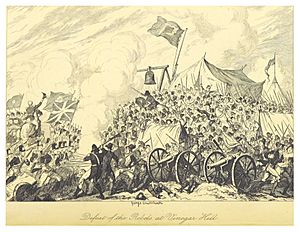Battle of Vinegar Hill facts for kids
Quick facts for kids Battle of Vinegar Hill |
|||||||
|---|---|---|---|---|---|---|---|
| Part of the Irish Rebellion of 1798 | |||||||
 "Defeat at Vinegar Hill" by George Cruikshank (1845) |
|||||||
|
|||||||
| Belligerents | |||||||
| Commanders and leaders | |||||||
| Strength | |||||||
| ~13,000 | ~16,000 | ||||||
| Casualties and losses | |||||||
| ~100 killed and wounded | ~1,200 killed | ||||||
The Battle of Vinegar Hill (Irish: Cath Chnoc Fhíodh na gCaor) was a big fight during the Irish Rebellion of 1798. It happened on June 21, 1798. About 13,000 government soldiers, led by Gerard Lake, fought against 16,000 United Irishmen rebels. The rebels were led by Anthony Perry.
This battle was a major defeat for the rebels. It took place on Vinegar Hill and in the streets of Enniscorthy, County Wexford. It was the last big effort by the rebels to control land they had taken in Wexford.
Why the Battle Happened
By June 18, 1798, a large government army had surrounded County Wexford. This army had about 13,000 soldiers and was ready to stop the rebellion.
The rebel leaders in the area asked all rebels to gather at Vinegar Hill. They wanted to face the government army there in a big battle. About 16,000 rebels came together. However, most of them did not have muskets (guns). Their main weapon was the pike, which is a long spear.
Thousands of women and children were also at the rebel camp. Many of them were "camp followers." This means they traveled with the army to help with things like cooking or caring for the wounded.
Before the battle, General Lake and his officers made a plan. They wanted to capture Vinegar Hill and defeat the rebels. Their plan was to surround the hill. They also wanted to take control of the only escape route. This route was a bridge over the River Slaney to the west of the hill.
Lake divided his army into four groups. Three groups would attack Vinegar Hill. These were led by David Dundas, James Duff, and Francis Needham. The fourth group, led by Henry Johnson, would capture the town of Enniscorthy. They also aimed to take a nearby bridge.
The Battle Begins

The battle started early on June 21 with cannons firing at the rebels. The government soldiers moved forward under the cover of the cannon fire. As they took over rebel positions, the cannons moved closer.
The rebels were forced to move further up the hill as the enemy closed in. This made them easy targets for the cannons. A new type of cannon ammunition, called shrapnel shells, was used. Hundreds of rebels were killed or wounded.
The rebels tried to charge the government forces twice. Both times, their attacks were pushed back. The situation for the rebels became very difficult.
Meanwhile, Johnson's group attacked Enniscorthy. This group included light infantry soldiers. The rebels in the town fought back strongly. They had made many buildings in Enniscorthy into strongholds.
The first attack on the town was stopped. Johnson's group lost several soldiers and some cannons. After getting more soldiers, including cavalry, Johnson ordered a second attack. This attack slowly pushed the rebels out of Enniscorthy. The lost cannons were also taken back. However, the rebels caused many injuries to the attackers. The rebels managed to defend the River Slaney bridge. This stopped Johnson's force from crossing it.
As the three attacking groups reached the top of Vinegar Hill, the remaining rebels began to leave. They escaped through a gap in the enemy lines. This gap was called "Needham's Gap." It existed because Needham's group moved slower than the others. This meant the hill was not completely surrounded.
Most of the rebels escaped through this gap. But many were trapped by the advancing soldiers. The cannons then switched to grape shot. This type of ammunition spreads out, causing more injuries.
In Enniscorthy, soldiers from Johnson's group set fire to a rebel aid station. Several wounded rebels died in the fire. The rebels left most of their supplies behind when they retreated. Thirteen cannons, which they had taken from government forces, were also recaptured.
What Happened Next
After the battle, people tried to guess how many rebels died. Estimates ranged from 400 to 1,200 killed. One historian, Kevin Whelan, believes between 500 and 1,000 rebels were killed. This includes the camp followers. A military witness, Archibald McLaren, said 1,200 rebels were killed. In comparison, the government forces reported about 100 killed and wounded. Rebel leader John Murphy was captured after the battle and executed.
After the battle, most of the rebel forces went back to the Three Rocks camp near Wexford. There, the rebel leaders decided to leave the camp. They split into two groups to continue the rebellion outside County Wexford. One group went west, and the other went north towards the Wicklow Mountains. They hoped to join up with Joseph Holt's rebels.
So, even though it was a big loss, the Battle of Vinegar Hill did not completely end the rebellion. However, it changed how the rebels fought. After this, they mainly used mobile warfare, raids, and guerilla operations. They no longer tried to hold large areas of land.
See also
- Castle Hill convict rebellion
- Vinegar Hill (Charlottesville, Virginia)
- Vinegar Hill, Brooklyn
Images for kids






